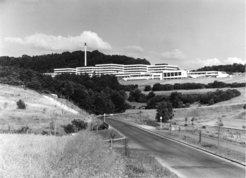The MPI for Biophysical Chemistry – how it all began
Manfred Eigen and Leo De Maeyer had discovered the expanse of meadow and farmland on the Faßberg hill while taking a walk around Nikolausberg: It was large enough to realize Eigen’s idea of founding a new Max Planck Institute with several departments and close enough to the city of Göttingen and the university. The physico-chemist had developed methods to measure ultra-fast reactions and other physical techniques, but to apply them to biological problems he needed more space than he and his colleagues at the then MPI for Physical Chemistry in Bunsenstraße had at their disposal.
Having recently received the Nobel Prize, Eigen was not short of offers to continue his research at renowned research institutions all over the world. And thus his idea of creating a new, larger institute by merging two existing MPIs in Göttingen – the MPI for Physical Chemistry and the MPI for Spectroscopy – found willing listeners within the Max Planck Society. Furthermore, his colleagues very much wanted him to remain as Director.

Budget and construction deadlines were met
Between 1968 and 1972, the institute shot up at the Faßberg – initially with five towers. It was designed by architect Walter Henn, who was also responsible for the construction work. The building specification covered 80 architectural plans as well as several thousand pages of documentation. It took 30 months for the whole building to be completed at a cost of around 47 million German Marks. Both the estimated budget and the construction deadline were met!
On May 10, 1972, the new institute on Faßberg hill was officially inaugurated in the presence of Max Planck President Adolf Butenandt. The scientific celebratory colloquium included talks by Sir John Eccles, Max Delbrück, and Manfred Eigen. The celebratory lecture given by Paul Harteck was dedicated to Karl Friedrich Bonhoeffer. In 1949, the physical chemist Bonhoeffer had re-established the former Kaiser Wilhelm Institute for Physical Chemistry in Göttingen.
The approach he followed was strongly interdisciplinary and he had an outstanding grasp of how to imbue young chemists, biologists, and physicists with the enthusiasm required to answer scientific questions on their own. As a special honor, the MPI for Biophysical Chemistry was given a second name in recognition of him: Karl Friedrich Bonhoeffer Institute.
The institute complex was spacious but had a somewhat monumental effect overall – “pressure to succeed cast in concrete” was the comment made by some of Göttingen’s residents at the time, who had an uncomfortable feeling that the money had come from the city’s coffers.
But this was not an accurate description of the institute by any means: The individual departments and labs were built to purpose as a result of the modular design concept. Thus, the 267 members of the institute staff who were there at the outset experienced a highly functional but by no means extravagant working environment.
By merging the two institutes, the Otto Hahn Library was also incorporated; it had been an independent institution of the Max Planck Society in Göttingen since 1946 and its basic holdings had come from the Kaiser Wilhelm Institutes in Berlin.
‘Newcomers’ and ‘old-timers’

There were initially five departments originating from the antecedent institutes, which increased by seven during the first years of the new institute’s life. “‘Newcomers’ and ‘old-timers’ enriched each other with suggestions and complementary specialist knowledge,” is how former Max Planck Director Otto Creutzfeldt described the situation in the publication Berichte und Mitteilungen der Max-Planck-Gesellschaft in 1975. “Numerous research groups are networked here and are working on finding solutions to special and general scientific problems – planned, spontaneous, competing with each other, and in rivalry.”
Following the tradition set by Manfred Eigen, the institute still maintains a strongly inter- and multidisciplinary approach, according to which the classical natural sciences – biology, chemistry, and physics – are interlinked and applied in studies of biological phenomena. This vision has endured for almost 50 years! (cr)

